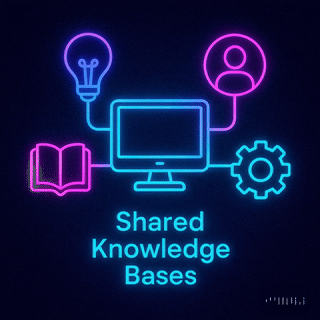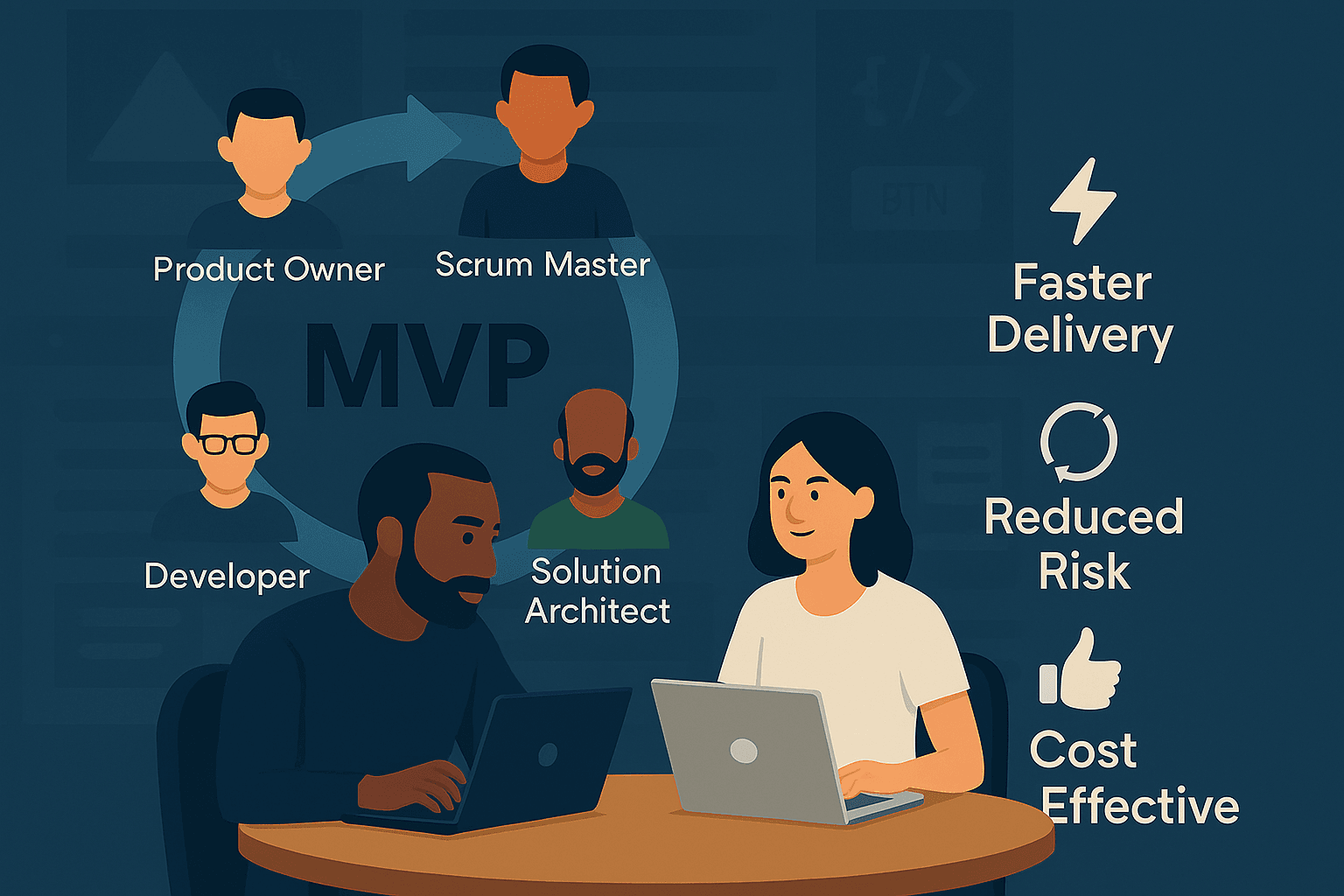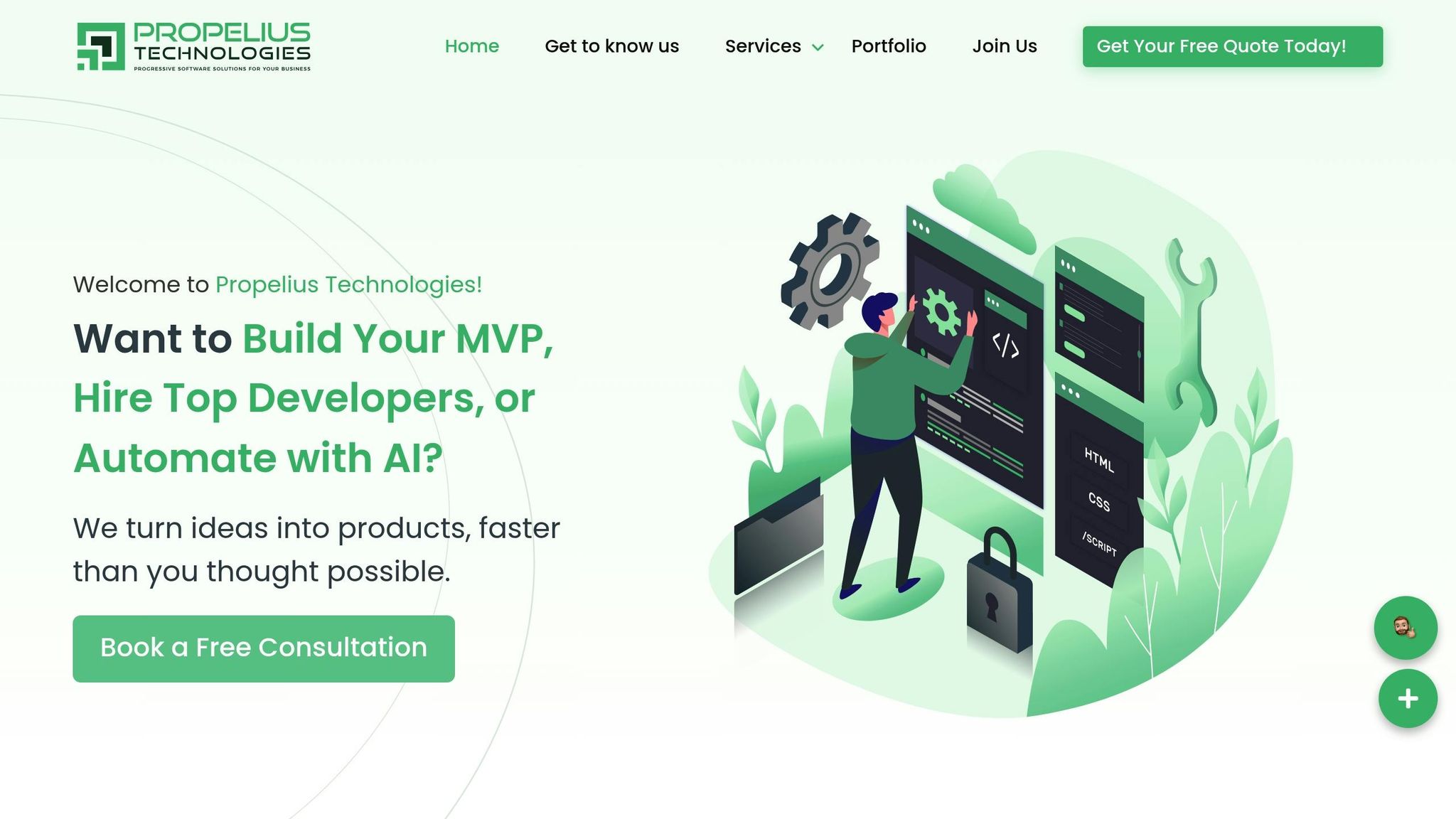
Tenant Data Isolation: Patterns and Anti-Patterns
Explore effective patterns and pitfalls of tenant data isolation in multi-tenant systems to enhance security and compliance.
Jul 30, 2025
Read More
Creating an MVP (Minimum Viable Product) with Agile methodology helps teams deliver faster, reduce risks, and build products users actually want. Here’s a quick summary of how Agile roles contribute to MVP success:
Want to know how these roles work together to build better products? Let’s dive in.
Turning a great idea into a successful MVP takes more than inspiration - it requires a well-coordinated team where everyone understands their role and works together effectively. Agile MVP development thrives on a few key roles, each contributing to the project’s success.
Here’s a closer look at these roles and why they’re essential.
The Product Owner acts as the link between your business goals and the development team. According to the Scrum Guide:
"The Product Owner is responsible for maximizing the value of the product resulting from the work of the Scrum Team".
While Product Managers focus on long-term strategies, the Product Owner zeroes in on the immediate value delivered by the development team. They handle the product backlog, prioritize features, and align stakeholders. Their decisions - like whether to prioritize a complex feature or refine the user experience - are guided by user needs and business value.
For an MVP, the Product Owner’s role is all about setting short-term priorities and ensuring the development team has clear, actionable user stories. This clarity prevents misunderstandings and keeps the team aligned.
Think of the Scrum Master as the team’s coach and problem-solver. They guide Agile practices, facilitate ceremonies, and remove obstacles that might slow down progress. A strong Scrum Master ensures everyone understands the purpose and goals of each sprint.
Collaboration with the Product Owner is key. As one expert explains:
"In the most effective team layouts, the Product Owner and Scrum Master are truly partners in a cohesive and mutually beneficial tag-team effort to get the best possible results from their team's efforts".
By fostering communication, refining the backlog, and maintaining team morale, the Scrum Master plays a critical role in keeping MVP development on track.
Developers take ideas and turn them into functional software. During Agile sprints, they build, test, and deliver increments of the MVP. Their work goes beyond coding - they’re involved in planning, problem-solving, and adapting to changes based on user feedback.
The Agile Manifesto emphasizes the importance of collaboration:
"Business people and developers must work together daily throughout the project".
This collaboration is especially important for MVPs, where flexibility and speed are essential. Developers ensure the software is not only functional but also maintainable, enabling the team to move quickly without sacrificing quality. Self-organizing and cross-functional teams are particularly valuable here, as they minimize delays caused by external dependencies.
Design is a cornerstone of any MVP. As one expert notes:
"Even the leanest MVP benefits immensely from thoughtful UX/UI design. It helps users understand, engage, and give meaningful feedback - which is the whole point of an MVP in the first place".
UX/UI Designers focus on creating user-friendly interfaces and gathering actionable feedback. They develop wireframes, prototypes, and design elements that align with sprint goals and user needs. By prioritizing usability, they ensure the MVP is intuitive and engaging, helping users quickly understand its value.
Good design also reduces confusion, leading to better user feedback and laying the groundwork for scalable design systems.
Solution Architects set the technical groundwork to avoid costly mistakes later. With one-third of custom software projects failing, their role is to establish a solid technical foundation.
They define the architecture, choose the tech stack, and manage risks. By balancing rapid development with future scalability, they ensure the MVP can grow without major rework. Solution Architects also act as translators, bridging the gap between technical teams and business stakeholders. They explain technical choices in a way that aligns with business goals, helping the team make informed decisions.
| Role | Primary Focus | Key MVP Contribution |
|---|---|---|
| Product Owner | Product vision and backlog management | Ensures features deliver maximum user value |
| Scrum Master | Process facilitation and obstacle removal | Maintains development velocity and team alignment |
| Developers | Code implementation and quality | Transforms requirements into working software |
| UX/UI Designer | User experience and interface design | Creates intuitive, feedback-generating user interactions |
| Solution Architect | Technical architecture and risk mitigation | Establishes scalable foundations for future growth |
Strong collaboration across these roles is the glue that holds Agile MVP development together. Each role complements the others - Product Owners rely on developers to bring their vision to life, Scrum Masters ensure smooth processes, and Solution Architects depend on input from both technical and business teams to make sound decisions. Communication and teamwork are at the heart of every successful MVP.
The success of a Minimum Viable Product (MVP) relies heavily on seamless teamwork and proven Agile practices that keep everyone aligned and moving swiftly.
Cross-functional teams combine diverse skill sets to transform ideas into functional products. Research shows that companies embracing this collaborative approach can boost team productivity by up to 35% and cut time-to-market by 20%. Even more compelling, organizations with a culture of collaboration are five times more likely to achieve major performance milestones.
Mike Cohn, a respected Agile expert, addresses a common misunderstanding about cross-functional teams:
"Perhaps the most prevalent and persistent myth in agile is that a cross-functional team is one on which each person possesses every skill necessary to complete the work. This is simply not true … A cross-functional team has members with a variety of skills, but that does not mean each member has all of the skills".
The concept of a T-shaped skill set is key here. It means that while team members have expertise in one area, they also have a working knowledge of other disciplines, enabling them to collaborate more effectively. For example, a developer may not specialize in UX design but can still understand enough to work closely with designers.
This team structure helps eliminate bottlenecks that often plague traditional workflows. Instead of waiting for one department to complete its tasks, cross-functional teams can make decisions quickly and adapt without lengthy approval processes. For MVPs, this agility helps avoid delays and budget overruns.
Strong teams align around shared goals and maintain a clear understanding of business challenges. When obstacles arise, open communication and collaborative problem-solving allow teams to address issues quickly.
With this foundation in place, Agile practices further enhance productivity and ensure ongoing improvement.
Effective Agile practices go beyond meetings - they’re designed to sustain momentum while prioritizing quality and adaptability.
Daily stand-ups are a hallmark of Agile MVP development. These short, focused meetings ensure everyone is on the same page about progress, roadblocks, and priorities. To maximize their impact, teams should keep these meetings concise, schedule them consistently, and encourage active participation. Notably, 87% of organizations use Scrum as their primary Agile framework, with daily stand-ups forming a critical part of the process.
Sprint planning and retrospectives are equally vital. During sprint planning, teams break down work into manageable tasks and prioritize features that deliver the most value to users. Retrospectives, on the other hand, provide an opportunity to reflect on successes, identify areas for improvement, and refine processes for the next sprint.
Agile methodologies have a proven track record of success. Teams using these approaches are 25% more productive, achieve project success rates three times higher than others, and experience 2.7x faster growth. ING Bank, for instance, reduced its time-to-market by 30% after adopting Agile practices.
Visual tools like Kanban boards, Gantt charts, and flow charts also play a crucial role. These tools help teams manage workflows, track progress, and limit work in progress, ensuring the MVP evolves effectively for user validation.
User feedback integration is another cornerstone of Agile development. By incorporating feedback after each sprint, teams can refine their product to better meet user needs. One e-commerce MVP project saw a 20% user adoption rate in its first month by consistently acting on user feedback throughout development.
While tools like project management platforms and file-sharing systems streamline workflows, the real driver of success is the team’s culture. Open communication, trust, and accountability are the foundation of effective collaboration.
William Rojas from Adaptavist sums it up well:
"The ability for the team to support each other, collaborate with each other and align to the goal are wonderful ways to measure agile".
Empowered teams that can make decisions and manage their work independently are a hallmark of Agile success. In fact, 93% of executives believe their teams could accomplish the same workload in half the time with better collaboration. This highlights the untapped potential of combining collaborative workflows with Agile practices to deliver high-quality MVPs quickly and effectively. These methods not only reduce risks but also ensure continuous improvement throughout the development process.
When Agile roles are clearly defined, MVP (Minimum Viable Product) success becomes much more achievable. Teams can deliver faster, reduce risks, and save costs - all while staying focused on their goals.
Having well-defined roles creates a strong sense of accountability, which directly lowers project risks. When team members know exactly what they're responsible for, delays caused by confusion or overlapping tasks vanish. Decisions are made faster, and progress becomes smoother. This clarity speeds up delivery and ensures the team stays on track.
The stats back this up. Companies that speed up their MVP process are 1.5 times more likely to exceed their business goals compared to slower teams. Additionally, MVP development can cut time-to-market by as much as 50%. Why? Because clear roles eliminate common issues like unclear ownership, duplicated work, and communication breakdowns.
Take Clinger, a dating app, as an example. By implementing Agile practices and assigning distinct responsibilities, Clinger transformed from a basic platform into a social-dating hybrid in just one year. Weekly sprints and clear accountability allowed the team to expand features quickly and scale effectively.
The cost savings are just as impressive. Agile development can slash costs by up to 70%. This happens because clear roles prevent costly mistakes like redundant work or fixing avoidable errors. When everyone understands their part, resources are used efficiently.
Reid Hoffman, the co-founder of LinkedIn, sums it up perfectly:
"If you're not embarrassed by the first version of your product, you've launched too late".
Clear roles make it possible for teams to move quickly and confidently, embodying this philosophy.
Defined roles don't just reduce risks - they also fuel ongoing improvement by creating a structured feedback loop. For example, the Product Owner gathers market feedback and turns it into actionable requirements. The Scrum Master ensures feedback sessions are consistent and productive. Developers then use technical insights to implement changes, while designers refine the user experience based on usability feedback. This systematic approach helps MVPs meet market needs more effectively.
Real-world examples highlight how this works. Fluint, a B2B SaaS startup, was struggling with its MVP development until NaNLABS stepped in with clear role definitions and Agile collaboration. Within 90 days, NaNLABS delivered a user-friendly platform for sales reps and buyers, enhanced the codebase for scalability, and launched a successful MVP.
Similarly, Popr.ai, which lacked internal technical expertise, partnered with NaNLABS to build its MVP. In just 90 days, NaNLABS helped Popr.ai attract a beta waitlist, reduce GIF generation time from 15 minutes to 15 seconds, and achieve early validation for its product. These successes were made possible by clear roles and a feedback-driven process.
Here's a quick look at how each Agile role contributes to better MVP outcomes:
| Role | Primary Responsibility | Impact on Time-to-Market | Cost Reduction Contribution | Quality Improvement |
|---|---|---|---|---|
| Product Owner | Define requirements and prioritize features | Prevents scope creep and keeps efforts focused | Reduces rework by prioritizing effectively | Improves market fit through feedback |
| Scrum Master | Facilitate processes and remove blockers | Speeds up delivery by resolving issues quickly | Prevents redundant efforts, optimizing resources | Maintains consistent quality standards |
| Developers | Build core functionality and features | Delivers working software in sprints | Avoids duplicate work with continuous integration | Quickly adapts to user feedback |
| UX/UI Designer | Create user-centered design solutions | Shortens validation cycles | Reduces redesign costs with early prototyping | Delivers intuitive, engaging user experiences |
| Solution Architect | Design scalable technical foundations | Anticipates future needs to avoid delays | Cuts costs with thoughtful architecture planning | Ensures a robust, maintainable codebase |
This table shows how clearly defined roles help teams prioritize essential features, speed up delivery, save money, and continuously improve. Each role brings unique expertise to the table, ensuring the MVP is both market-ready and adaptable.

Propelius Technologies brings Agile principles to life with delivery models designed to streamline MVP development. By combining clear role definitions with adaptable engagement strategies, they ensure every project benefits from structured teamwork and fast-paced iteration.
"We embrace collaborative, iterative, and transparent decision-making."
This approach consistently delivers impactful results.
The Turnkey Delivery model is built around Agile roles within a fixed-price framework, removing uncertainty from the development process. With this model, clients receive a fully cross-functional team where each member plays a distinct role in driving the MVP's success.
One standout feature of this model is the 90-day MVP sprint. Here, the Product Owner collaborates closely with clients to define and prioritize features, ensuring the MVP aligns with market needs. Meanwhile, the Scrum Master oversees weekly sprints, clearing obstacles and keeping progress steady.
"We turn ideas into products, faster than you thought possible."
Developers focus on writing clean, efficient code using tools like React.js and Node.js, while UX/UI designers craft intuitive interfaces that can be quickly validated. The Solution Architect ensures scalability, helping businesses avoid costly overhauls down the line.
This model also incorporates a shared-risk approach, offering a 10% delay discount per week (up to 50%) to underline their commitment to Agile efficiency. By working as integrated full-stack teams, every member understands how their contributions fit into the broader vision. Designers consider development constraints, developers collaborate with QA to test thoroughly, and the entire team works in sync to deliver faster without compromising quality.
When flexibility is needed, this model transitions smoothly into the Developer-for-Hire option.
The Developer-for-Hire model embeds Propelius Technologies' specialists directly into an existing team. Instead of replacing internal structures, they enhance them with pre-vetted engineers who hit the ground running.
"We build long-term partnerships by integrating our experts as part of your team."
These developers seamlessly adopt the client’s Agile practices. For instance, React Native developers don’t just write code - they actively collaborate with product managers, participate in code reviews, and address challenges as they come up.
This model is ideal for businesses with established Agile roles but in need of extra expertise. Whether it’s senior developers skilled in React.js and Node.js or the ability to scale teams dynamically, the flexible hourly billing structure adapts to the needs of each sprint without disrupting workflows.
Propelius Technologies' cross-functional approach enhances productivity. Agile teams have been shown to be 25% more productive than their peers, and their track record - over 650 web applications and 250 mobile apps delivered - proves the effectiveness of their methods. This productivity boost stems from seamless collaboration among roles. For example, the Solution Architect works with UX/UI designers during planning to address user flow from the outset.
Their U.S.-localized delivery ensures smooth collaboration with American businesses. From using the MM/DD/YYYY date format to properly formatting dollar amounts (e.g., $10,000.00) and applying imperial measurements when needed, Propelius Technologies prioritizes the details that matter to U.S. clients.
This emphasis on collaboration extends to decision-making. In 2022, 37% of respondents reported using Agile/Scrum methods for software development. Propelius Technologies has refined their process to ensure every role contributes meaningfully. Product Owners work with Solution Architects to address technical limitations and collaborate with designers to enhance usability.
Through a process they call "informed iteration", every sprint review becomes an opportunity for team-wide input. Developers provide technical insights that shape design decisions, designers offer usability feedback to improve features, and Scrum Masters ensure these discussions stay focused and productive.
This integrated approach allows Propelius Technologies to deliver MVPs that launch faster, cost less, and maintain exceptional quality - showcasing the power of Agile roles working in unison.
Agile practices transform MVP development into a powerful strategy. When teams embrace clearly defined roles and prioritize collaboration, they consistently deliver products that address real market needs with speed and precision.
Agile teams have been shown to be 25% more productive than their peers in the industry. This increase stems from well-defined roles that promote accountability and smooth teamwork. For example, when Product Owners focus on prioritizing features with the highest user value, Scrum Masters tackle obstacles, and developers concentrate on clean, effective code, the team operates efficiently and purposefully.
Defined roles also enable quicker decision-making and allow teams to pivot rapidly based on user feedback. This flexibility is especially important for MVPs, which depend on fast iterations. Agile roles encourage ongoing improvement through structured feedback, ensuring that user input is translated into actionable tasks that keep development aligned with market needs.
Eric Ries famously described an MVP as "the version of a new product which allows a team to collect the maximum amount of validated learning about customers with the least effort". By clarifying roles, Agile reduces risks and supports early pivot decisions. Collaborative efforts - where UX/UI designers work closely with developers and Solution Architects plan for scalability early - help avoid costly course corrections later.
Additionally, clear role definitions enhance communication. Regular check-ins ensure that assumptions are validated and teams remain aligned throughout the process.
These principles lie at the heart of Propelius Technologies' Agile methodologies.
Propelius Technologies has mastered the implementation of Agile roles, drawing from experience with over 100 successful projects. Their proven approach balances speed and quality through clear accountability and efficient workflows.
One standout example is their 90-day MVP sprint, which showcases how well-defined Agile roles can drive rapid progress. With a dedicated Product Owner prioritizing tasks and a Scrum Master ensuring smooth sprints, clients see consistent, measurable results. Their shared-risk model, offering up to a 50% delay discount, reflects their confidence in their Agile processes and role clarity.
For businesses with existing teams, Propelius offers a Developer-for-Hire model. This allows pre-vetted engineers - skilled in technologies like React.js and Node.js - to integrate seamlessly into ongoing Agile workflows. These engineers actively participate in daily stand-ups, retrospectives, and cross-functional collaboration without disrupting established processes.
Propelius' cross-functional team approach ensures that every role contributes to MVP success. Solution Architects collaborate with designers early in the planning stages, developers work closely with QA throughout sprints, and Product Owners maintain open communication with stakeholders. This alignment prevents the silos that often derail MVP projects.
With 37% of software development teams now using Agile/Scrum methods, the benefits of this methodology are clear. Propelius Technologies builds on this foundation with their expertise, clear role definitions, and collaborative culture - turning MVP concepts into market-ready products that resonate with users.
In the world of MVP development, the roles of Product Owner (PO) and Scrum Master are distinct yet interconnected, each playing a crucial part in the process.
The Product Owner is all about the what and why. They shape the product's vision, gather input from stakeholders, and prioritize the product backlog. Their primary goal is to ensure the team is building features that align with both business objectives and user needs. Essentially, they make key decisions about the product's direction, always aiming to deliver value.
The Scrum Master, on the other hand, focuses on the how. They ensure the Agile process runs smoothly, helping the team work efficiently while sticking to Agile principles. By clearing roadblocks, encouraging collaboration, and guiding workflows, the Scrum Master keeps the team on track and aligned with the MVP's goals. In short, while the PO sets the strategy, the Scrum Master ensures the development process runs like a well-oiled machine.
Cross-functional teams unite professionals from various disciplines, creating an environment where collaboration thrives and creative solutions emerge. This setup allows teams to tackle challenges more effectively, ensuring no critical aspect of a project is overlooked.
By eliminating silos, these teams streamline workflows and accelerate decision-making, which helps speed up the delivery of MVP features. Their self-organizing structure fosters accountability and independence, leading to higher morale and a shared focus on customer-centric objectives. This approach prioritizes essential features and ensures they are delivered based on real user feedback, resulting in better outcomes in a shorter time frame.
A Solution Architect is essential when it comes to building an MVP that can evolve alongside your business. Their job? To design an architecture that's flexible and modular, capable of adapting as your needs grow. They make critical decisions about technologies and architectural patterns - like microservices - that not only support scalability but also make future updates and expansions easier to manage.
By identifying potential risks and technical challenges early, they help sidestep bottlenecks that could slow growth. This proactive mindset ensures the MVP aligns with your long-term vision while making the most of resources for both immediate and future requirements.
Need an expert team to provide digital solutions for your business?
Book A Free CallDive into a wealth of knowledge with our unique articles and resources. Stay informed about the latest trends and best practices in the tech industry.
View All articlesGet in Touch
Let's Make It Happen
Get Your Free Quote Today!

Get in Touch
Let's Make It Happen
Get Your Free Quote Today!

